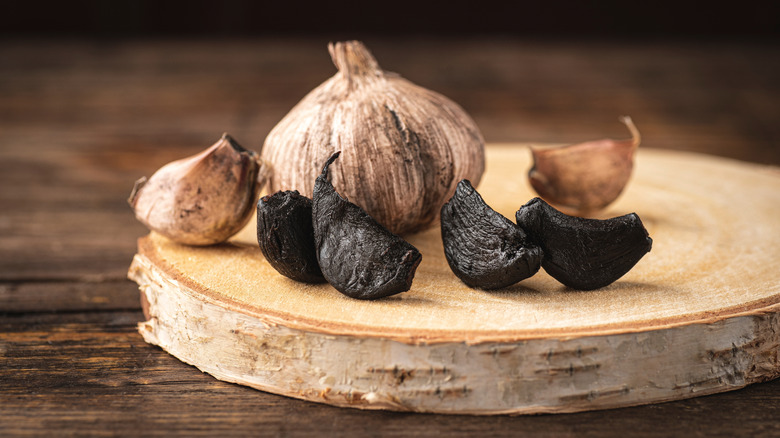What Does Black Garlic Taste Like & How Does It Differ From Regular Garlic?
If you've never heard of black garlic or don't know much about it, you might think it's a different variety than the kind you usually have in your kitchen. However, it's actually the same garlic we use all the time; it's just gone through a specific aging process. That doesn't mean, however, that the two are alike, as Jem Mantiri, a vegan food recipe blogger at The Fruity Jem, told Food Republic: "Black garlic is very different from regular garlic in both taste and texture." She detailed the taste differences, explaining, "Regular garlic is sharp, pungent, and slightly spicy, while black garlic is deeply caramelized, with sweet, umami-rich notes similar to balsamic vinegar and molasses after fermentation." Mantiri also described what it does in cooking, saying, "Instead of adding savory flavor like regular garlic does, black garlic enhances dishes with a mellow, sweet, and complex depth."
Black garlic's mellowness carries through in its aroma too, which Mantiri called "much milder, lacking the strong sulfuric bite of raw garlic." As a bonus, this means there's no bad garlic breath to worry about when eating black garlic (although there is a drink that keeps bad breath at bay when you're eating garlic-heavy dishes.) The garlic also becomes softer, with Mantiri saying, "Texture-wise, regular garlic is firm and crisp, whereas black garlic becomes soft and spreadable."
How is black garlic made?
Regular garlic transforms into black garlic when it's kept at 140 to 190 degrees Fahrenheit in humid environments for several weeks. While fermentation plays a role in this transformation, so does the Maillard reaction. This heat-driven chemical reaction between a food's amino acids and sugars causes browning, transforming the garlic's appearance and flavor.
You could attempt to make black garlic yourself by leaving a head of garlic in a slow cooker set to a temperature in the necessary range for about three weeks. Wrapping the top of the cooker with aluminum foil helps maintain the humidity, as does resisting the temptation to lift the lid and peek at it too often. Be aware though: This process creates a powerful garlic smell. So, if you do try it, keep the cooker in the garage or a room with the door closed and a window open. Once it's done, leave the garlic in its skin; this is the best way to store black garlic.
Remember that you can't substitute black garlic for fresh garlic; the flavors are too different. However, you could use them together. Beyond that, there are many ways to use this unique product, including blending it into sauces, stews, or soups, rubbing it on chicken or fish before roasting, or making a compound butter for steak. You can also use black garlic to elevate a simple garlic bread recipe. In other words, the options are almost endless.


